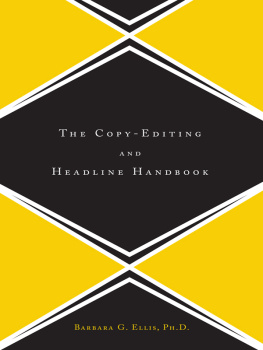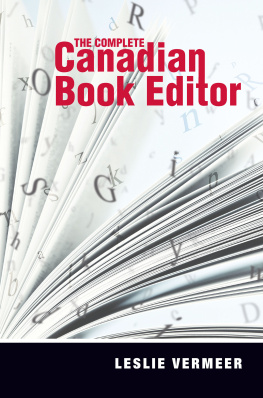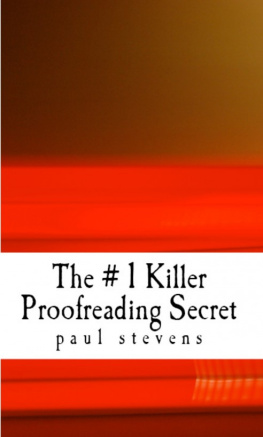

Copyright 2006 by The McGraw-Hill Companies, Inc. All rights reserved. Except as permitted under the United States Copyright Act of 1976, no part of this publication may be reproduced or distributed in any form or by any means, or stored in a database or retrieval system, without the prior written permission of the publisher.
ISBN: 978-0-07-150606-9
MHID: 0-07-150606-3
The material in this eBook also appears in the print version of this title: ISBN: 978-0-07-145764-4, MHID: 0-07-179465-4.
All trademarks are trademarks of their respective owners. Rather than put a trademark symbol after every occurrence of a trademarked name, we use names in an editorial fashion only, and to the benefit of the trademark owner, with no intention of infringement of the trademark. Where such designations appear in this book, they have been printed with initial caps.
McGraw-Hill eBooks are available at special quantity discounts to use as premiums and sales promotions, or for use in corporate training programs. To contact a representative please e-mail us at bulksales@mcgraw-hill.com.
Notice
Medicine is an ever-changing science. As new research and clinical experience broaden our knowledge, changes in treatment and drug therapy are required. The authors and the publisher of this work have checked with sources believed to be reliable in their efforts to provide information that is complete and generally in accord with the standards accepted at the time of publication. However, in view of the possibility of human error or changes in medical sciences, neither the authors nor the publisher nor any other party who has been involved in the preparation or publication of this work warrants that the information contained herein is in every respect accurate or complete, and they disclaim all responsibility for any errors or omissions or for the results obtained from use of the information contained in this work. Readers are encouraged to confirm the information contained herein with other sources. For example and in particular, readers are advised to check the product information sheet included in the package of each drug they plan to administer to be certain that the information contained in this work is accurate and that changes have not been made in the recommended dose or in the contraindications for administration. This recommendation is of particular importance in connection with new or infrequently used drugs.
Contents
ONE
Who Proofreads
TWO
Ways to Proofread
THREE
Proofreading Skills
FOUR
Remembering What You Read
FIVE
Understanding the Writers Language and Querying Effectively
SIX
Giving Clear Instructions
SEVEN
Working with Type
EIGHT
Understanding the Typesetters Language
A
The Proofreaders Tools
B
McGraw-Hills General Instructions for Freelance Proofreaders
C
Proofreading Checklists
D
Words and Phrases Commonly Confused or Misused
E
General Office Style Sheet
F
Manuscript Style Sheet
G
Client Style Sheet
Introduction
The written word is often the first impression a business makes on a prospective customer or client. If it isnt spelled right, if it isnt punctuated right, if it doesnt look good on paper, the business loses credibility.
Ideally, everything written in any office should be read for errorstypographical, spelling, grammatical, punctuation, and formatwhether it is an annual report, an in-house publication, advertising copy, or a business letter. But even in those offices where the copy has been read for errors, mistakes slip through. More often than not, the reason this happens is because the copy was not proofread by a person trained for the job. There is a difference.
Some people, even aspiring proofreaders, do not understand what the word proofreader actually means, how proofreading differs from any other method of reading, or what distinguishes the proofreader from any other kind of reader. Following are definitions of all three: the title, the job, and the proofreader.
THE TITLE
Taken literally, the word proofreader is a present-day misnomer. The job dates from the advent of the printing press. Proofs, or first impressions of printed copy, were pulled from the press so that the proof reader could check them for typographical errors. When the typewriter, then the computer, were invented, other kinds of typos werent far behind. Because the task of reading for typed errors was virtually the same as reading for printed errors, the title proofreader stuck. So whether reading for errors on typed copy, on a desktop monitor, or on a readers proof, laser print, or printers proof, the one who performs the task is a proofreader.
THE JOB
In its most fundamental form, however, the job itself has changed. Computerized typing and typesetting, programmed with spelling and hyphenation checks, have encroached on the proofreaders original domain, threatening to eliminate those readers whose talents are limited to catching the most obvious mistakes.
But for the reader whose knowledge and interest lie beyond the eternal typo, computerization provides both relief and challenge. What was once a restrictive, often tedious occupation, is now an exciting opportunity to help ensure perfection through every step of the process and to become a far more valuable member of the communications team. For even the most sophisticated desktop equipmentnow featuring grammar and punctuation checks, typesetting, and vast graphics capabilitieshas not yet eliminated the need for a final, human stamp of approval. The system is still only as smart as the person who operates it. And proofreaders who capitalize on both its advantages and drawbacks not only increase their worth to the company but also widen their employment horizons immensely.
Technology has indisputably changed the proofreaders job requirements forever. As a result, employers are beginning to tighten their hiring standards. Proofreaders who can meet those expectations are being offered a higher salary and much more responsibility.
While proofreading is only one link in the communications chain (the progression of the written word from conception through production), the skills it requires are some of the most essential. The modern, state-of-the-art proofreader can save the company expense and embarrassment by catching a variety of obvious and not-so-obvious mistakes before they reach the costly stage of printand ultimately the ever-critical eye of the intelligent reader.
THE PROOFREADER
Finding this kind of proofreaderor becoming one yourselfisnt easy. The job calls for technical knowledge of both language and print. It requires an aptitude, both inherent and acquired, for reading. And through each stage, it demands expertise and adaptability to the job at hand.
From typed concept to print, the copy passes through many stages and through numerous hands. And as is evident in the stages outlined below, the proofreader plays a central and essential role in the entire process, reading the copy for the different kinds of errors that can occur at each stage of development.
Next page










